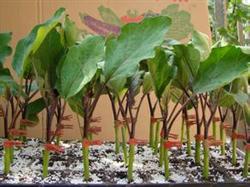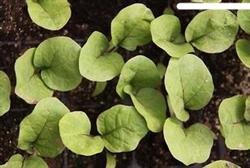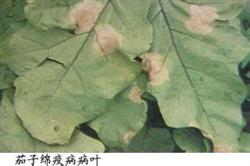Annual cultivation techniques of grafted eggplant

With the expansion of eggplant cultivation area and continuous planting, all kinds of soil-borne diseases are quite common, and the harm is becoming more and more serious, such as eggplant Verticillium wilt, Fusarium wilt, bacterial wilt and so on. in the old areas of eggplant cultivation, soil-borne diseases have become stubborn diseases that limit eggplant production, and conventional pesticides have not achieved good control effects. Grafting has become a necessary means to overcome soil-borne diseases and improve eggplant yield and efficiency. The grafted eggplant has strong resistance and can be produced throughout the year. According to our large-scale experiments and demonstrations in Shangqiu City over the past three years, the annual cultivation of grafted eggplant can increase the yield by 40-50% compared with conventional cultivation, and the plots with serious diseases can double the yield. The annual cultivation techniques of grafted eggplant are introduced as follows. 1. Eggplant grafting seedlings eggplant grafting commonly used rootstocks are Tolubam, Chaotorubam, red eggplant, spiny eggplant and other wild and semi-wild species. These rootstocks are highly resistant or immune to soil-borne diseases such as Verticillium wilt, Fusarium wilt, bacterial wilt, nematode disease and other soil-borne diseases of eggplant, and are cold-resistant, drought-resistant and moisture-tolerant. Torubam is often used as rootstock in production at present. 1. Sowing date. Eggplant was sown with rootstocks at the beginning of January. In order to make the optimal grafting period of rootstock and scion consistent, rootstock should be 25-30 days earlier than scion, and red eggplant should be 7-10 days earlier. Tolubam has a strong dormancy period. When sowing, it is necessary to use 100-200 mg / kg gibberellin or soak in eggplant rootstock for rapid budding. 2. Post-broadcast management. Before the emergence of rootstocks and scions after sowing, the low ground temperature needs to be heated to emerge seedlings. The seedling bed soil temperature rootstock (Tolubam) requires 30-35 ℃, and the scion requires 25-30 ℃. Eggplant seedlings are most prone to stunting disease, and the bed soil should be mixed with carbendazim or seedling enemies. Cover, and spray with 72.2% Prik 500x solution for 2-3 times after emergence. 3. Divide the seedlings. When the rootstock seedlings grow to 2-3 leaves, the seedlings are divided into 10 cm × 12 cm nutrition bowls to facilitate grafting operation and planting. Scion seedlings can not be divided if they are sparsely sown. 4. Grafting. Eggplant is generally grafted by split grafting. When 5-6 leaves of rootstock seedlings and 3-4 leaves of scion seedlings are suitable for grafting, keep 2-3 leaves of rootstock first, cross-cut the stem with a blade, remove the upper part, then split it from the middle of the stem, cut down 1-1.5 cm longitudinally, then remove the upper 2-3 leaves of the scion, and cut off the lower part with a blade. Cut the incision into 1-1.5 cm long wedge-shaped, the size of the wedge should be the same as the rootstock cut, then insert the scion into the incision, pay attention to the two incision epidermis to be aligned, clamped with grafted pods. 5. Management after grafting. After grafting, the seedlings were moved into the small arch shed as soon as possible to shade. Fully watered, no ventilation in the first 6-7 days, maintain more than 95% humidity, 25-28 ℃ during the day, 20-25 ℃ at night, shade completely in the first 3-4 days after grafting, and then half shade, gradually remove the grass with the wound healing, and gradually ventilate, maintain a high air humidity during the ventilation period, and transfer to normal management after complete survival. Second, planting 1, soil preparation and fertilization. Eggplant is a deep-rooted crop with a long growing period and likes great water and fertilizer. Before planting, it is necessary to apply sufficient base fertilizer, using fermented farm manure or chicken manure 8000-10000 kg per mu, cake fertilizer 300-500kg, three-element compound fertilizer 50-100kg, turning 30-40 cm deep, and cuddling flat. 2. Planting. Before planting, a high border of 15-20 cm was made with a wide row of 70-80 cm and a narrow row of 50-55 cm. A watering ditch was opened between the two narrow rows, and a 1.1-meter wide plastic film was covered to benefit the roots, water and reduce diseases. Planting requires soil temperature above 12 ℃, plant spacing 40-50 cm, planting 2000-2500 plants per mu, drilling holes, watering, and then planting. Do not bury the interface when planting, and the interface should be 3-5 cm higher than the ground, so as to prevent the scion from rooting and causing disease. Early spring cultivation can be combined with small arch shed mulching, the benefit will be greatly improved. Third, cultivation management 1, vegetative growth period management. 3-5 days after planting grafted eggplant, pour a slow seedling water, the amount of water should not be too large, in order to prevent the soil temperature from falling, the key to this period is to increase the temperature, promote rooting, make the plant grow healthily, and lay a good foundation for high yield in the future. 2. Hormone dipping in flowers. In order to ensure that the door eggplant sits, prevent falling flowers and promote the rapid expansion of the fruit, it is necessary to dip the door eggplant into the flower with hormone. When the eggplant flower is half-blooming, dip it with 40-60 mg / kg of 2-methylethyl-4-methyl D plus 100 mg / kg gibberellin. When dipping flowers, add 1-2 grams of Sukeling or paracetamol per kilogram of medicine solution, which can not only prevent falling flowers, disease, but also promote precocious, generally use a brush to smear above the sepals, pay attention to the liquid should not be too much. 3. Water and fertilizer management. After the door eggplant fruit is settled, the door eggplant egg yolk can be watered and topdressing, and the principle of fertilization is not only to ensure enough nitrogen fertilizer but also to cooperate with phosphorus and potassium fertilizer. Apply urea 10 kg, potassium sulfate 10 kg, diammonium phosphate 10 kg per mu, mixed hole application, and watering. After the eggplant is harvested, the eggplant can grow vigorously, which can be combined with watering for topdressing, and can be used with chemical fertilizer and organic fertilizer, each time 20 kg of ternary compound fertilizer or 1000 kg of organic fertilizer per mu. 4. Pruning and branching. Grafted eggplant has strong growth potential and long growth time, and there are no lateral branches below the door eggplant. Generally, the common pruning method is used to keep fruit according to the door eggplant, the pair eggplant and the four doors. In the middle and later stage of growth, the lower old and diseased leaves can be removed, which can be ventilated, transparent, prevent rotten fruit, increase coloring, and improve fruit quality. 5. Harvest in time. When the fruit reaches physiological maturity, the timely harvest not only has good quality, but also does not affect the development of the upper fruit, especially the eggplant should be harvested early. Another principle is that eggplant should grow well, harvest late when appropriate, and harvest early if it is weak. The harvest time should be in the afternoon, and the handle should be cut off with scissors instead of twisting and dragging. Fourth, pruning and regeneration. With the rise of the fruiting part of eggplant, the plant is too high, easy to lodge, the upper fruit is small and the color is not good, so the Beginning of Autumn pruned and regenerated 10 cm above the eggplant. After pruning, all the leaves on the plant are knocked off, and then the three-element compound fertilizer is 20-30kg per mu and watered once to promote the germination of new branches. after the new branches germinate, there are many branches. When the new branches are 5-10cm, leave 4 branches with the same growth to leave fruit, and the rest of the branches will be beaten away. The practice shows that the grafted eggplant grows strong after pruning and regeneration, and the eggplant grows big and coloured well, which is another yield peak. Generally, the second stubble eggplant can be put on the market 30-40 days after pruning. In order to postpone the harvest, some farmers add small arched sheds and grass cottages to the market 30-50 days after Frosts Descent, so that the benefit is even higher. Fifth, pest control 1. Disease. After grafting, eggplant overcame the most important soil-borne diseases such as Verticillium wilt and Fusarium wilt. The disease is mild, but there are also diseases such as brown streak and cotton blight that cause rotten eggplant in the field. Chemical control can be controlled by 75% Dakening 500 times, 64% alum 500 times, 72% urea manganese zinc 600 times, and so on. 2. Insect pests. The main pests of eggplant are red spider, tea yellow mite, 28 star ladybug and so on. In recent years, the occurrence of tea yellow mite is serious and has a development trend, which mainly harms the tender leaves and fruits. After the damage to the tender leaves, the edge of the leaves curls downward, the back of the leaves is oily, the fruit is damaged, the fruit surface is rough, and the pericarp is cracked seriously, showing the shape of flowering steamed bread and losing edible value. The chemical control of tea yellow mites should be sprayed with 1.8% avermectin 3000 times, 5% nisolang 1500 times, 15% mites 2000 times, 73% gram mites 1000 times, and should be sprayed mainly on the tender parts and the back of leaves.
- Prev

Measures to prevent eggplant from falling flowers and fruits in greenhouse
The technology of cold bed seedling raising and transplanting of hot pepper and eggplant in greenhouse is the main measure to increase early yield, early fruit, early market and high benefit. First, the shed construction chooses to avoid the wind and the sun, flat terrain, fertile soil, convenient drainage and irrigation, low groundwater level, close to water sources, and has not planted eggplant fruits and vegetables for many years.
- Next

Control of cucumber blight and eggplant cotton blight
The disease symptoms of cucumber blight can occur in both seedling stage and adult stage, and mainly harm the stem base, tender stem nodes, leaves and fruits of the plant at the adult stage. At first, dark green water stains appeared at the stem base and stem nodes, then softened, the stem nodes were significantly constricted and thinned, and the leaves above the diseased part wilted or the whole plant died. The leaf is infected with disease.
Related
- Where is it suitable to grow horseradish in China? it is expected to see the middle altitude horseradish in Alishan.
- How to prevent tomato virus disease reasonably? (Control methods included)
- Many people like to plant towel gourd on the balcony. What are the main points of this method and management?
- What crops can chili peppers be mixed with?
- Fertilization techniques and matters needing attention in Tomato
- What are the grafting techniques for peach seedlings in spring?
- Harm and control methods of root swelling disease of Chinese cabbage
- What are the pests of sweet potatoes? How to prevent and cure it?
- Symptoms, causes and Control methods of navel Rot in Tomato
- The cause of "Cucumber rotten bibcock" in Farmers' planting Cucumber and its Control Plan

